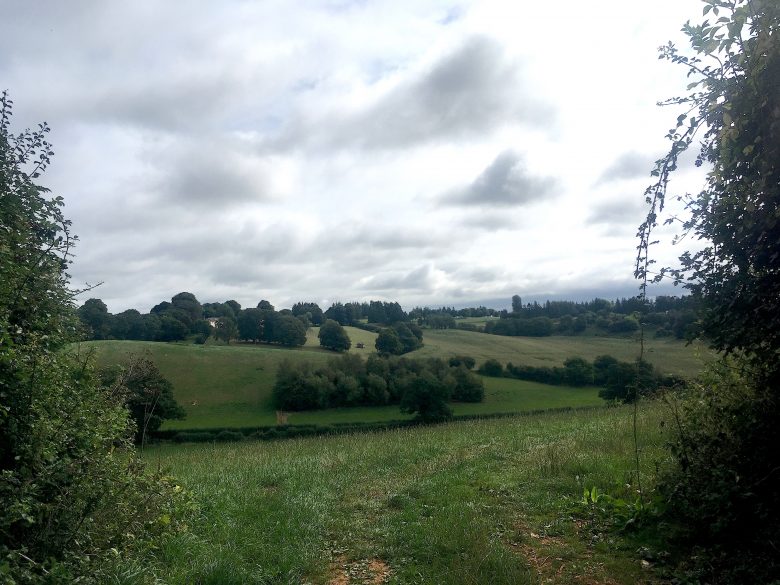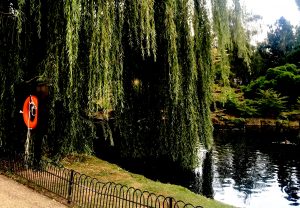There is something very special about traveling to somewhere you’ve only visited before in books. Anne Fadiman has an essay about it in Ex Libris called “You Are There”; you can read some of the essay here. I don’t have a vivid imagination when I read, but there are places that capture your heart when you read about them and make you want to get up and go there.
I have gone on literary pilgrimages before. A few years ago I wrote about the most deliberate one for The Toast – a visit to Wales, in the footsteps of Susan Cooper’s The Dark is Rising series – but I also went many years ago to Concord, Massachusetts, and saw Lousia May Alcott’s home. I’ve been to Bath, where some of Jane Austen’s characters walked, on a school trip, and to the Lake District, where Elizabeth Bennet didn’t get to go in Pride and Prejudice. On that trip I visited Beatrix Potter’s house, and William Wordsworth’s. And lots of authors have written about New York City, even if I didn’t quite go looking for the places they wrote about.
I went to Sherborne, Dorset, last week, because of a book, but part of the pilgrimage was accidental. Peter Beagle is best known for The Last Unicorn, which I did read back in the day, but the book of his that I’ve read again and again is Tamsin. Tamsin is the story of thirteen-year-old Jenny Gluckstein. Or rather, it’s nineteen-year-old Jenny’s story of what happened to her thirteen-year-old self when her mother fell in love with an Englishman and moved Jenny and her Mister Cat from an apartment in Manhattan to a dilapidated, rambling house in a farm in Dorset, England. Some people think it’s a little slow or self-indulgent, but somehow Peter Beagle, a grown man, captures what it feels like to be a thirteen-year-old girl perfectly.
And then there are the ghosts. Because this isn’t a school story about being a moody teenager, it’s a ghost story. The ghosts don’t come in right away, but one lends her name to the title of the book and it’s Tamsin and her ghost cat, Miss Sophia Brown, who teach Jenny about the world of Dorset after dark. Jenny and her new stepbrother encounter a boggart, but it’s with Tamsin that she meets the Pooka, a trickster who can change form and from whom you should never accept a ride from when he appears as a horse; the billy-blind, whose advice is sometimes helpful; and the Black Dog, who appears to give a warning like the Grim in the Harry Potter books.
It was Tamsin which made me want to go to Dorset, and when I was considering what part of Dorset to visit, I opened the book and realized Jenny attends a private school in Sherborne. I Googled Sherborne, saw that it was a beautiful market town and easy to reach by train, and I booked my travel.
Despite Tamsin’s inspiration, I did not make this into a pilgrimage. I walked by a school in town, but I didn’t go out of my way to find Jenny’s school. I took a walk that brought me past farms, but I didn’t try to search for the farm Jenny’s family lives on, if it even exists. And while I walked home a little after sunset at least once, I didn’t go walking on a farm in the dark to see if I could meet the Pooka or the billy-blind.
I did one quick Google Map search of the town, though. The story of Tamsin is caught up in the history of the Monmouth Rebellion of 1685, a piece of British history I may have learned about in high school but certainly remember more because of this book. The rebellion was unsuccessful, and the king of the time, James II, sent Judge Jeffreys to bring those who’d been part of the rebellions to trial in what came to be known as the Bloody Assizes. Many people were executed and Jeffreys is a reviled figure in Dorset and known as the Hanging Judge.
Judge Jeffreys and his story are part of Tamsin, and the book mentions a restaurant named after him where his portrait hangs. My Google Map search of Sherborne came up with nothing and I concluded that it must have been made up for the book, forgetting that the restaurant was in the building where Jeffreys’s apartments had been during the trials.
On my last day in Sherborne, I took a bus to see Minterne Gardens (beautiful, they deserve their own post) and then continued on to Dorchester. Dorchester apparently figures in Thomas Hardy’s books, of which I’ve read none, and I was just curious to wander around. I visited the remains – including mosaic floors – of a Roman villa, spotted what was once a Roman amphitheater, and even went in a small photography exhibit.
When I had about forty-five minutes left till I needed to catch the bus back to Sherborne, I decided to wander down one of the main streets of shops and see what was there. When I reached the end of it, I turned and saw across the street the Dorset County Museum, advertising half price admission, which I had read about earlier. I decided to stop in long enough to take a look and use the restroom. As I got ready to cross the street I looked down it and there was the Judge Jeffreys.
The restaurant was closed and seemed to be in the process of turning over to become a different restaurant, but there was the name, and there was his face on the sign. Jenny had gone to Dorchester to see the portrait, and it had slipped my mind completely.
I went in the museum and took a look around. I Googled to see if there was any connection to Judge Jeffreys in the museum – there was not, but one website hinted that some people think his ghost haunts the museum. When I spoke to a few members of the staff, they said nearby there are tunnels underground to different buildings and that Jeffreys likely used them to go to and from his courtroom.
If I had had more time, I might have gone in a nearby church that figured into the Assizes, or just walked around to get a sense of the place. But I had to catch my bus back to Sherborne.
I have to admit, when I saw the Judge Jeffreys sign, I shivered a little in my shock. Dorchester does not seem like a big town, but I was only there for a few hours, and I could have just as easily not turned onto that street. My pilgrimage was, as I said at the beginning, a complete accident. I would call it a happy one – I certainly was glad to see it! – but Judge Jeffreys and his legacy are not happy, and there is something a bit eerie about the feeling that I was drawn there. Especially if you’ve read the book…








